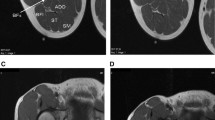Abstract
The purpose of this study was to examine the reliability and validity of the “panoramic” brightness mode ultrasonography (US) method to detect training-induced changes in muscle cross-sectional area (CSA) by comparison with results obtained using magnetic resonance imaging (MRI). Out of 27 young male volunteers, 20 subjects were assigned to training group and seven to non-training control group. Muscle CSAs of vastus lateralis were analyzed by MRI and US before and after 21 weeks of either heavy resistance training or control period. Measured by both the US and MRI, the resistance training induced significant increases (~13–14%, P < 0.001) in muscle CSA, whereas no changes were observed in control group. A high repeatability was found between the two consequent US measurements (intraclass correlation coefficient, ICC of 0.997) with standard error of measurement (SEM) of 0.38 cm2 and smallest detectable difference of 1.1 cm2. Validity of the US method against MRI in assessing CSA of VL produced ICC of 0.905 and SEM of 0.87 cm2 with high limits of agreement analyzed by Bland and Altman method. However, the MRI produced systematically (10 ± 4%, P < 0.01) larger CSA values than the US method. The US showed high agreement against MRI in detecting changes in muscle CSA (ICC of 0.929, SEM of 0.94 cm2). The results of this study showed that the panoramic US method provides repeatable measures of a muscle CSA although MRI produced larger absolute CSA values. Moreover, this US method detects training-induced changes in muscle CSA with a comparable degree of precision to MRI.





Similar content being viewed by others
References
Bemben MG (2002) Use of diagnostic ultrasound for assessing muscle size. J Strength Cond Res 16:103–108
Beneke R, Neuerburg J, Bohndorf K (1991) Muscle cross-section measurement by magnetic resonance imaging. Eur J Appl Physiol Occup Physiol 63:424–429
Berg HE, Tedner B, Tesch PA (1993) Changes in lower limb muscle cross-sectional area and tissue fluid volume after transition from standing to supine. Acta Physiol Scand 148:379–385
Bland JM, Altman DG (1986) Statistical methods for assessing agreement between two methods of clinical measurement. Lancet 1:307–310
Dons B, Bollerup K, Bonde-Petersen F, Hancke S (1979) The effect of weight-lifting exercise related to muscle fiber composition and muscle cross-sectional area in humans. Eur J Appl Physiol Occup Physiol 40:95–106
Engstrom CM, Loeb GE, Reid JG, Forrest WJ, Avruch L (1991) Morphometry of the human thigh muscles. A comparison between anatomical sections and computer tomographic and magnetic resonance images. J Anat 176:139–156
Esformes JI, Narici MV, Maganaris CN (2002) Measurement of human muscle volume using ultrasonography. Eur J Appl Physiol 87:90–92
Häkkinen K, Pakarinen A, Kraemer WJ, Häkkinen A, Valkeinen H, Alen M (2001) Selective muscle hypertrophy, changes in EMG and force, and serum hormones during strength training in older women. J Appl Physiol 91:569–580
Howe TE, Oldham JA (1996) The reliability of measuring quadriceps cross-sectional area with compound B ultrasound scanning. Physiother Res Int 1:112–126
Hulmi JJ, Kovanen V, Selänne H, Kraemer WJ, Häkkinen K, Mero AA (2009) Acute and long-term effects of resistance exercise with or without protein ingestion on muscle hypertrophy and gene expression. Amino Acids 37:297–308
Ikai M, Fukunaga T (1968) Calculation of muscle strength per unit cross-sectional area of human muscle by means of ultrasonic measurement. Int Z Angew Physiol Einschl Arbeitsphysiol 26:26–32
Kanehisa H, Ikegawa S, Fukunaga T (1998) Body composition and cross-sectional areas of limb lean tissues in Olympic weight lifters. Scand J Med Sci Sports 8:271–278
Mitsiopoulos N, Baumgartner RN, Heymsfield SB, Lyons W, Gallagher D, Ross R (1998) Cadaver validation of skeletal muscle measurement by magnetic resonance imaging and computerized tomography. J Appl Physiol 85:115–122
Rankin G, Stokes M (1998) Reliability of assessment tools in rehabilitation: an illustration of appropriate statistical analyses. Clin Rehabil 12:187–199
Reeves ND, Maganaris CN, Narici MV (2004a) Ultrasonographic assessment of human skeletal muscle size. Eur J Appl Physiol 91:116–118
Reeves ND, Narici MV, Maganaris CN (2004b) Effect of resistance training on skeletal muscle-specific force in elderly humans. J Appl Physiol 96:885–892
Sipilä S, Suominen H (1993) Muscle ultrasonography and computed tomography in elderly trained and untrained women. Muscle Nerve 16:294–300
Sipilä S, Suominen H (1996) Quantitative ultrasonography of muscle: detection of adaptations to training in elderly women. Arch Phys Med Rehabil 77:1173–1178
Walton JM, Roberts N, Whitehouse GH (1997) Measurement of the quadriceps femoris muscle using magnetic resonance and ultrasound imaging. Br J Sports Med 31:59–64
Weir JP (2005) Quantifying test–retest reliability using the intraclass correlation coefficient and the SEM. J Strength Cond Res 19:231–240
Acknowledgment
This study was supported in part by a grant from the Ministry of Education, Finland.
Author information
Authors and Affiliations
Corresponding author
Additional information
Communicated by Roberto Bottinelli.
Rights and permissions
About this article
Cite this article
Ahtiainen, J.P., Hoffren, M., Hulmi, J.J. et al. Panoramic ultrasonography is a valid method to measure changes in skeletal muscle cross-sectional area. Eur J Appl Physiol 108, 273–279 (2010). https://doi.org/10.1007/s00421-009-1211-6
Accepted:
Published:
Issue Date:
DOI: https://doi.org/10.1007/s00421-009-1211-6




